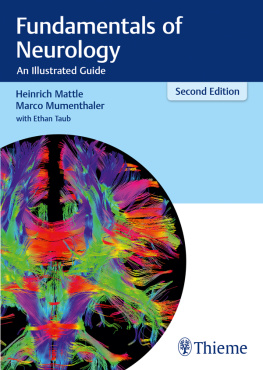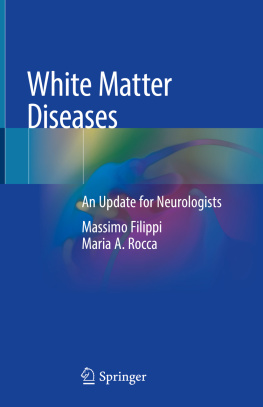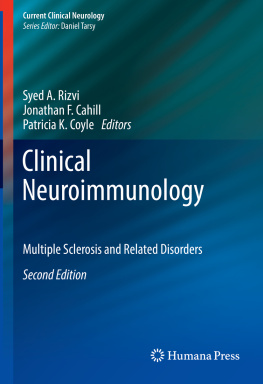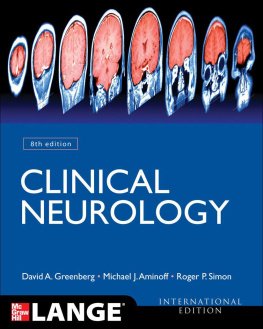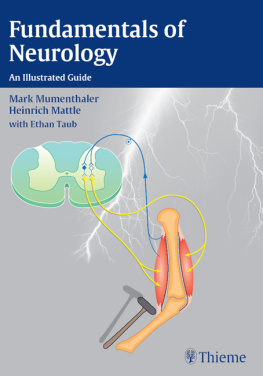At a Glance


Illustration by Robert Wyss
(19252004)
Fundamentals of Neurology
An Illustrated Guide
2nd Revised and Updated Edition
Heinrich Mattle, MD
Professor of Neurology
Senior Consultant and formerly Vice-Chairman of the Department of Neurology
Head of the Neurological Policlinic and Stroke Center
Inselspital, University of Bern
Bern, Switzerland
Marco Mumenthaler, MD
Professor of Neurology
Formerly Chairman of the Department of Neurology
Inselspital, University of Bern
Bern, Switzerland
With assistance from the
Institute for Diagnostic and Interventional Neuroradiology
Inselspital, University of Bern
Bern, Switzerland
Professor Jan Gralla, MD
Professor Gerhard Schroth, MD
Translated and adapted by Ethan Taub, MD
567 illustrations
Thieme
Stuttgart New York Delhi Rio de Janeiro
Library of Congress Cataloging-in-Publication Data is available from the publisher.
This book is an authorized translation of the 4th German edition published and copyrighted 2015 by Georg Thieme Verlag, Stuttgart. Title of the German edition: Kurzlehrbuch Neurologie
Translator: Ethan Taub, MD, Department of Neurosurgery, University Hospital Basel, Basel, Switzerland
Illustrators: Karin Baum, Paphos, Cyprus; Malgorzata and Piotr Gusta, Paris, France; and Helmut Holtermann, Dannenberg, Germany
2017 by Georg Thieme Verlag KG
Thieme Publishers Stuttgart
Rdigerstrasse 14, 70469 Stuttgart, Germany
+49 [0]711 8931 421,
Thieme Publishers New York
333 Seventh Avenue, New York, NY 10001 USA
+1 800 782 3488,
Thieme Publishers Delhi
A-12, Second Floor, Sector-2, Noida-201301
Uttar Pradesh, India
+91 120 45 566 00,
Thieme Publishers Rio de Janeiro, Thieme Publicaes Ltda.
Edifcio Rodolpho de Paoli, 25 andar
Av. Nilo Peanha, 50 Sala 2508
Rio de Janeiro 20020-906 Brasil
+55 21 3172 2297/+55 21 3172 1896
Cover design: Thieme Publishing Group
Cover image: www.siemens.com/presse
Typesetting by DiTech Process Solutions, Mumbai, India
Printed in Germany by AZ Druck, Kempten
5 4 3 2 1
ISBN 978-3-13-136452-4
Also available as an e-book:
eISBN 978-3-13-202212-6
Important note: Medicine is an ever-changing science undergoing continual development. Research and clinical experience are continually expanding our knowledge, in particular our knowledge of proper treatment and drug therapy. Insofar as this book mentions any dosage or application, readers may rest assured that the authors, editors, and publishers have made every effort to ensure that such references are in accordance with the state of knowledge at the time of production of the book.
Nevertheless, this does not involve, imply, or express any guarantee or responsibility on the part of the publishers in respect to any dosage instructions and forms of applications stated in the book. Every user is requested to examine carefully the manufacturers leaflets accompanying each drug and to check, if necessary in consultation with a physician or specialist, whether the dosage schedules mentioned therein or the contraindications stated by the manufacturers differ from the statements made in the present book. Such examination is particularly important with drugs that are either rarely used or have been newly released on the market. Every dosage schedule or every form of application used is entirely at the user's own risk and responsibility. The authors and publishers request every user to report to the publishers any discrepancies or inaccuracies noticed. If errors in this work are found after publication, errata will be posted at www.thieme.com on the product description page.
Some of the product names, patents, and registered designs referred to in this book are in fact registered trademarks or proprietary names even though specific reference to this fact is not always made in the text. Therefore, the appearance of a name without designation as proprietary is not to be construed as a representation by the publisher that it is in the public domain.
This book, including all parts thereof, is legally protected by copyright. Any use, exploitation, or commercialization outside the narrow limits set by copyright legislation without the publisher's consent is illegal and liable to prosecution. This applies in particular to photostat reproduction, copying, mimeographing or duplication of any kind, translating, preparation of microfilms, and electronic data processing and storage.
For our grandchildren Alma, Mio, and Jim, who give us a lot of joy
Heinrich Mattle, MD
For Stephi, with deep gratitude and love
Marco Mumenthaler, MD
Contents
Foreword
The second edition of Fundamentals of Neurology by Mattle and Mumenthaler is an excellent introductory neurology textbook that covers a broad range of topics related to how to approach patients with neurologic and muscular disorders. The initial chapters describe how to interview, examine, and order/interpret appropriate testing for such patients and then how to use the information to localize where in the nervous system the likely abnormality is. Subsequent chapters cover in detail a broad range of commonly encountered neurologic and muscular diseases. Major strengths of the book include the straightforward and easily understood presentation of the material, the excellent numerous figures and tables, and the comprehensive discussion of a wide range of neurologic and muscular disorders.
Fundamentals of Neurology is an appropriate introductory neurology textbook for medical students, trainees in a variety of medical disciplines, including neurology, and physicians in practice who need an easily accessible source of information about neurologic and muscular disorders. I highly recommend it to all of these physicians and physicians in training, and predict that it will be frequently used by them as they encounter patients with neurologic and muscular disorders.
Marc Fisher, MD
Professor, Department of Neurology
Beth Israel Deaconess Medical Center
and Harvard Medical School
Boston, Massachusetts, USA
Preface
Just a few decades ago, neurology and the neurosciences in general were contemplative disciplines oriented toward clinical phenomena and their correlation with pathoanatomic findings. Definitive diagnosis and treatment were only rarely feasible. Today, clinicians and researchers can use newly developed technologies to detect a wide variety of diseases of the central and peripheral nervous system. With the advent of improved diagnostic methods, computer technology, microtechnology, and new, highly effective drugs, neurology is no longer merely contemplative and has become a highly dynamic field. Many symptomatic and, often, causally directed treatments are now available for the treatment or even prevention of neurologic disease.
Fundamentals of Neurology provides a window onto the fascinating world of clinical neurology. Although students sometimes find neurology bewilderingly complicated, it is in fact firmly based on logic and the known correlations between clinical phenomena and the sites of the lesions that cause them. In the first few chapters of this book, the emphasis lies on fundamentals, the clinical examination, topical diagnosis, and the differential diagnosis of neurologic manifestations and syndromes. This knowledge equips the student to understand the subsequent chapters, which concern diseases of the central and peripheral nervous system. For most patients, the history and physical examination will point to the correct neurologic diagnosis. Targeted ancillary testing can be used to verify, document, and refine the presumptive diagnosis that has already been made on clinical grounds, and thus lead the way to proper treatment. Today more than ever, it bears repeating that the clinical neurologic evaluation is indispensable; the clinical findings provide a context for the proper interpretation of the ancillary test findings, so that the correct treatment can be chosen.

